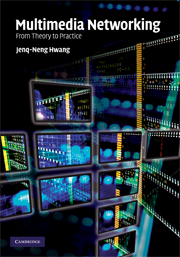Book contents
- Frontmatter
- Contents
- Preface
- Acknowledgements
- List of abbreviations
- 1 Introduction to multimedia networking
- 2 Digital speech coding
- 3 Digital audio coding
- 4 Digital image coding
- 5 Digital video coding
- 6 Digital multimedia broadcasting
- 7 Multimedia quality of service of IP networks
- 8 Quality of service issues in streaming architectures
- 9 Wireless broadband and quality of service
- 10 Multimedia over wireless broadband
- 11 Digital rights management of multimedia
- 12 Implementations of multimedia networking
- Index
Preface
Published online by Cambridge University Press: 26 January 2010
- Frontmatter
- Contents
- Preface
- Acknowledgements
- List of abbreviations
- 1 Introduction to multimedia networking
- 2 Digital speech coding
- 3 Digital audio coding
- 4 Digital image coding
- 5 Digital video coding
- 6 Digital multimedia broadcasting
- 7 Multimedia quality of service of IP networks
- 8 Quality of service issues in streaming architectures
- 9 Wireless broadband and quality of service
- 10 Multimedia over wireless broadband
- 11 Digital rights management of multimedia
- 12 Implementations of multimedia networking
- Index
Summary
With the great advances in digital data compression (coding) technologies and the rapid growth in the use of IP-based Internet, along with the quick deployment of last-mile wire line and wireless broadband access, networked multimedia applications have created a tremendous impact on computing and network infrastructures. The four most critical and indispensable components involved in a multimedia networking system are: (1) data compression (source encoding) of multimedia data sources, e.g., speech, audio, image, and video; (2) quality of service (QoS) streaming architecture design issues for multimedia delivery over best-effort IP networks; (3) effective dissemination multimedia over heterogeneous IP wireless broadband networks, where the QoS is further degraded owing to the dynamic changes in end-to-end available bandwidth caused by wireless fading or shadowing and link adaptation; (4) effective digital rights management and adaptation schemes, which are needed to ensure proper intellectual property management and protection of networked multimedia content.
This book has been written to provide an in-depth understanding of these four major considerations and their critical roles in multimedia networking. More specifically, it is the first book to provide a complete system design perspective based on existing international standards and state-of-the-art networking and infrastructure technologies, from theoretical analyses to practical design considerations. The book also provides readers with learning experiences in multimedia networking by offering many development-software samples for multimedia data capturing, compression, and streaming for PC devices, as well as GUI designs for multimedia applications. The coverage of the material in this book makes it appropriate as a textbook for a one-semester or two-quarter graduate course.
- Type
- Chapter
- Information
- Multimedia NetworkingFrom Theory to Practice, pp. xiPublisher: Cambridge University PressPrint publication year: 2009

